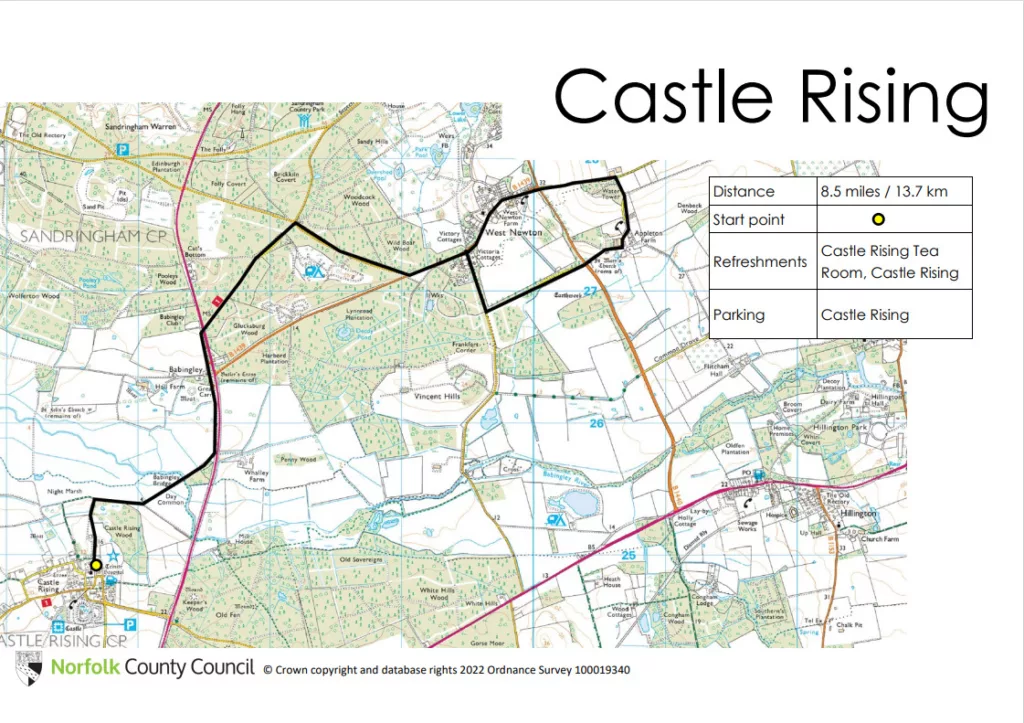Castle Rising Castle still sits dominant in the landscape, its extensive twenty acres of impressive earthworks certainly makes a bold statement. In the 14th century, Queen Isabella, the ‘She-Wolf’, was imprisoned here by her son for the alleged murder of Edward II. It is one of the best preserved and lavishly decorated keeps. The keep dates to around 1140 AD and has served many purposes from defensive to a prison and a hunting lodge. The latter is an important part of its story as it was once the centre of a huge deer chase and deer park to the south of the castle. The circular shaped outline can still be traced in the landscape today when inspected on a map.
Looking north from Castle Rising Wood, the remains of St Felix’s Church, a scheduled monument that was rebuilt in the 14th century can be seen. At one time a substantial population lived here, but this declined during the later medieval and post-medieval periods. The church sits north of the Babingley River, which at one time was a navigable estuary, Castle Rising was a thriving port. Local tradition tells that the church marks the spot where St Felix of Burgundy landed in AD 631 on his mission to convert the East Angles. Archaeological finds provide evidence for a settlement here from at least the 8th century. Tax returns of 1331 show that the village was well populated, but this had declined to just eight by the beginning of the 17th century. The church was described as `greatlie decaied’. In 1895 it was replaced by a smaller church, built by the Prince of Wales, but the churchyard was still used for burials into the early 20th century.
The church also marks the northern extent of the Castle Rising Chase, which once extended across many parishes. This land was controlled by the lords of rising, not just for deer, but also wood and rabbits. The warrens at Grimston were important sources of meat and fur, although, the rabbits fought back. During the subsequent centuries they escaped from the warrens and multiplied to such an extent that their tunnelling undermined the walls of the castle and caused whole walls to collapse. Poetic justice as it was the Normans who introduced them as a meat source.
The small village church at West Newton has been a favourite with the royal family for generations. Inside its carrstone exterior there is a window dedicated to the King’s lost Sandringham battalion, whose fate was for many years remained a mystery. During the First World War, these local men led by Captain Frank Beck went into battle and just disappeared into a smoke ridden battlefield. Many years later their unmarked graves were found, and evidence suggests they were executed by enemy forces after being captured.
The spectacular sixty-foot Appleton Water tower was built after, Edward, Prince of Wales fell ill with typhoid 1871 while staying on the royal estate at Sandringham, as did his eldest son three years later. James Mansergh’s neo-Byzantine polychromic design, with its differently coloured red bricks stands prominently overlooking Sandringham. Mansergh realised the upper levels of the tower would command spectacular views of the Royal estate, so reserving the second-floor room for royal family use. The floor above accommodated the mechanics. There is even a separate entrance and stair for exclusive Royal use, thus avoiding any workmen or servants. Today the building is rented as holiday accommodation, so you can now use the Royal staircase without fear.

